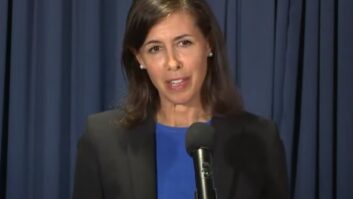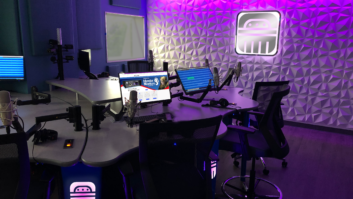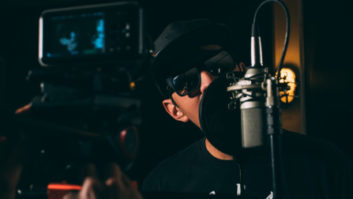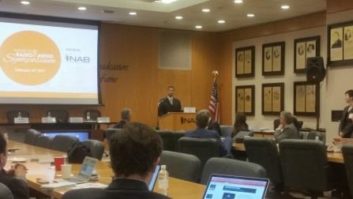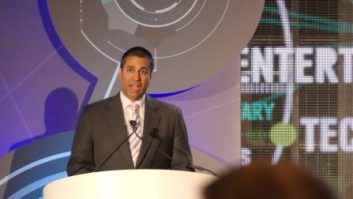
Next Radio 2015 took place in the Royal Institution’s famous lecture theatre. Courtesy Next Radio
LONDON — The historic lecture theatre in the United Kingdom’s Royal Institution, where Faraday first demonstrated electromagnetism, was a fitting venue for the fifth Next Radio conference.


“Don’t be boring!” says Valerie Geller
at Next Radio. Courtesy Next Radio
The brainchild of “radio futurologist” James Cridland and Folder Media’s Creative Director Matt Deegan, its fast-moving nine- and 18-minute sessions offered a mix of sometimes light-hearted, sometimes moving, but always thought-provoking new ideas for radio.
Jasmine Cox from BBC Research & Development demonstrated the Playlister button, a physical device that the listener can push to bookmark a moment of broadcast content. Users then later sync the button with an app, in order to access and share the content when convenient. The button forms “a real world extension” of functionality that is already available on BBC Playlister.
Meanwhile, another button, allowing listeners to skip songs on live radio, was demonstrated by Dominick Born of TPC Switzerland. “MusicBan” replaces the track by pulling in a YouTube track instead, and then opting back into the broadcast when the song finishes. Going further, a particular artist can be banned from ever being played in a stream.

Rupert Brun, former BBC Radio head
of technology, explains binaural
audio. Courtesy Next Radio
As more people use headphones to listen to audio, in particular on smartphones, former BBC Radio Head of Technology Rupert Brun called for the greater adoption of binaural audio — surround sound for headphones. Brun explained that complex microphones are no longer needed to record binaural, as regular stereo recordings can now be transformed into binaural using plug-ins available for most audio editing systems.
Social media was well represented too, with Will Guyatt demonstrating Facebook Live’s video broadcasts, being trialled by Ian Collins of London’s talk station, LBC. It lets public figures — such as radio presenters — broadcast live videos onto followers’ news feeds. The new feature is available for verified pages and profiles, and can be shared by the station’s page; the video remains available on demand, and allows users to comment afterwards.
“Tell the truth, make it matter and don’t be boring” was the mantra for presenters from consultant Valerie Geller, who added “there are no boring stories, only boring storytellers.” As if to confirm this, one of the strongest stories at the conference was a compelling description from Angela Robson and Showers Jalloh of how their “Pikin to Pikin Tork” radio program, broadcast on stations in the Kailahun district of eastern Sierra Leone, helps save the lives of children affected by war and Ebola in Sierra Leone.
Videos of these and the other sessions from Next Radio 2015 are available on the website at nextrad.io.
